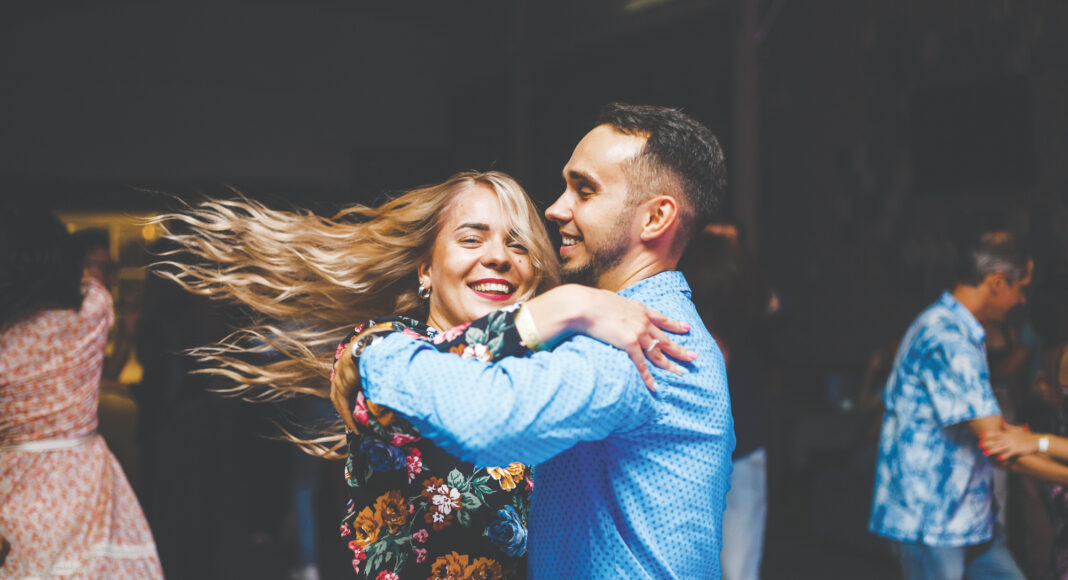With a slight shudder and soft “ding,” the ancient elevator opens on the mezzanine level of the Palomar Inn Hotel in downtown Santa Cruz. It’s like a tale of two cities—on the right side, shabby, stained, torn, gray carpet leads the way to even-shabbier numbered tenements. On the left, lush potted palms and gold-leafed mirrors line the plush, burgundy rug leading to a well-made black reception desk and the elegance and opulence of the Palomar Ballroom.
The ornate blue-and-gold art deco carvings frame the main ballroom’s heavy, ancient wooden doors, leading to the mirrored, brightly-lit 1,800 square-foot area that has emerged as the hub of the dance scene in Santa Cruz County.
Dancing at the luxurious yet ornate ballroom dates back to the swinging 1930s—when boogieing down to big live bands and even-bigger music was America’s most popular social pastime. When founder Steve Hughes and the Palomar Ballroom Dance Company took over the space in 1997, it was rough and slightly weathered but brimming with history and potential.
After extensive renovations and repairs, the new Palomar Ballroom opened and emerged as the preeminent local dance spot we see today, offering highly lauded private and group instruction in both International and American Ballroom and Latin dances for both recreation and competition.
Sporting a well-tailored and snug head-to-toe black ensemble and excellent posture, Jeremy Pilling floats into a comfy plush leather chair in the ballroom’s spacious lobby. His looks are youthful and boyish—there’s no way this guy is 47.
Pilling, current owner and head instructor at the Palomar, has been teaching and performing in the ballroom for over 23 years—and dancing all of his life socially. He can do it all on the dance floor—but he specializes in American Smooth, American Rhythm and International Latin.
Pilling can be a technique-oriented taskmaster on the dance floor, but he says that “dancing is all about fun.” The relaxed yet poised instructor-in-chief invites me into the bright, echoing and gleaming confines of the Palomar’s main ballroom to get a feel for the place and watch him in action, teaching a group salsa class. When I hear “Lord, Make a Rainbow” start pulsing through the high-end sound system, I know this will be fun.
Blinking and twinkling yellow lights hang above the large, shiny wooden main ballroom dance floor. In the center of the action hangs a large ornate, well-lit metal chandelier nestled among lines of ancient, painted and patterned wooden beams.
Pilling’s students—a total of eight women and nine men—walk into the bright, professional and historic space semi-quietly, with deference, and get prepared on red and gold chairs lining the floor and facing a fully-mirrored wall. Boots and jackets off. Dancing shoes on.
Pilling has owned and been one of the head dance instructors at the Palomar Ballroom since 2000. But he, his successful company and the local dance scene barely survived the pandemic.
“We were closed for most of it,” he says. “When you dance, you’re a foot away from someone and breathing in their face. But we made it through; we are still here. A lot of people were excited to come back and get back into dancing. We all missed it.”
Now, business is booming, and most of the Palomar Ballroom’s group classes and private lessons are either full or close to full.
As they bounce or sashay down the ballroom’s cushy, carpeted mezzanine halls, most dancers wear a smile on their face and have a twinkle in their eyes—to go along with sharp, sometimes-extravagant outfits and composed demeanors. Most seem healthy, blissfully happy and pretty-darn physically fit.
“Dancing is exercise, but you don’t think of it that way. It’s not like jumping on the treadmill,” Pilling explains. “If you’re doing a lot of dancing, you definitely will burn a ton of calories. It’s a cardiovascular workout, and you get your muscular endurance and coordination. But it helps keep you sharp mentally as well; you’re constantly using your brain to learn and remember patterns and things.”
Some visitors, and those semi-new to the world of dance, ask instructors like Pilling just how long it will take to get good at dancing. How long until they can say cha-cha confidently, do the hustle or swing in public at a nightclub?
Pilling admits that, like anything, “it’s all about repetition.” Performing one of the 17 styles of dance depends on how quickly one learns and absorbs information. It does take some dedication.
“We get everyone,” he says. “Folks from 16 to 80-year-olds. Anyone can learn how to dance. Some people just learn and pick it up faster than others.”
Visit palomarballroom.com for more info.













